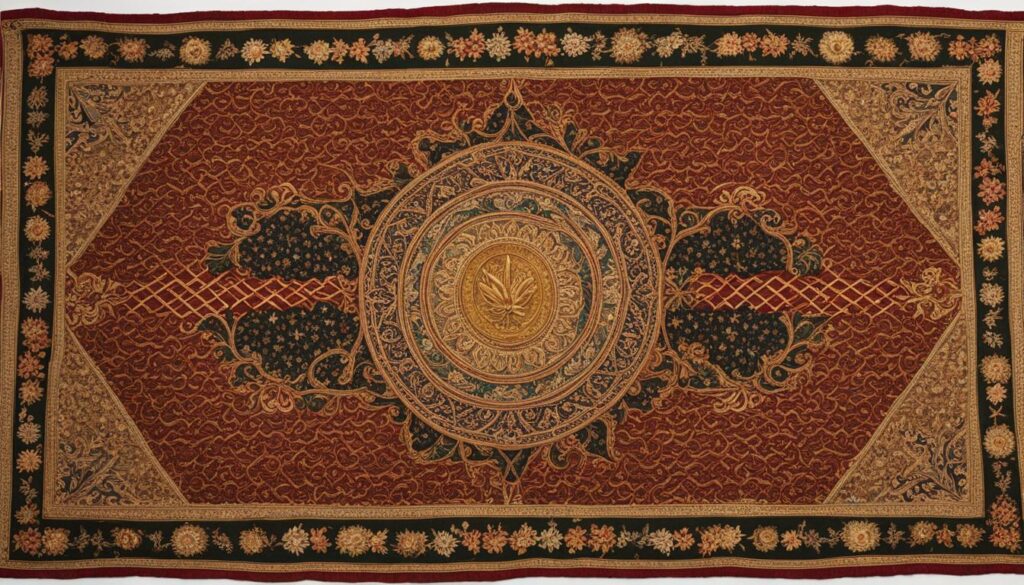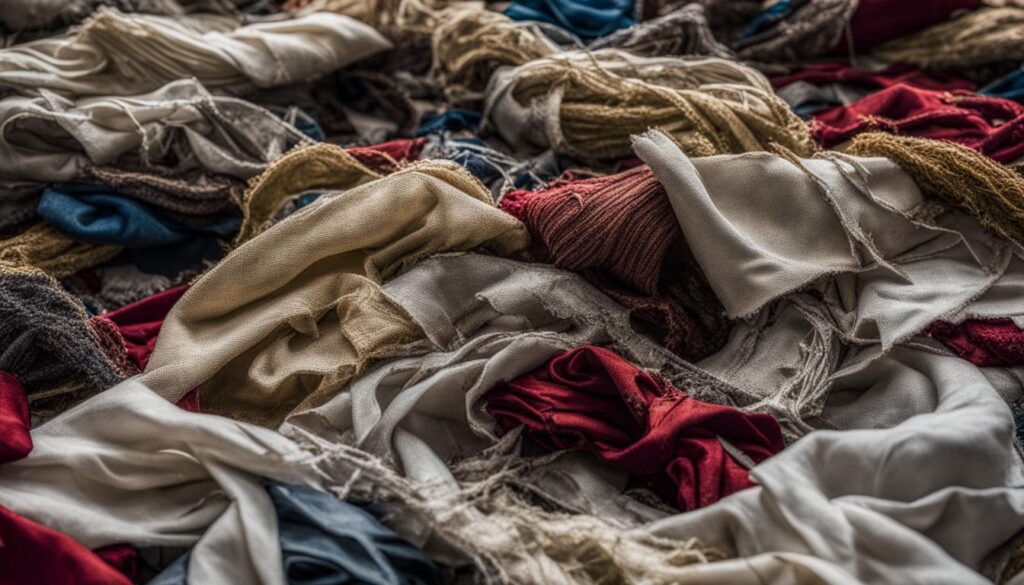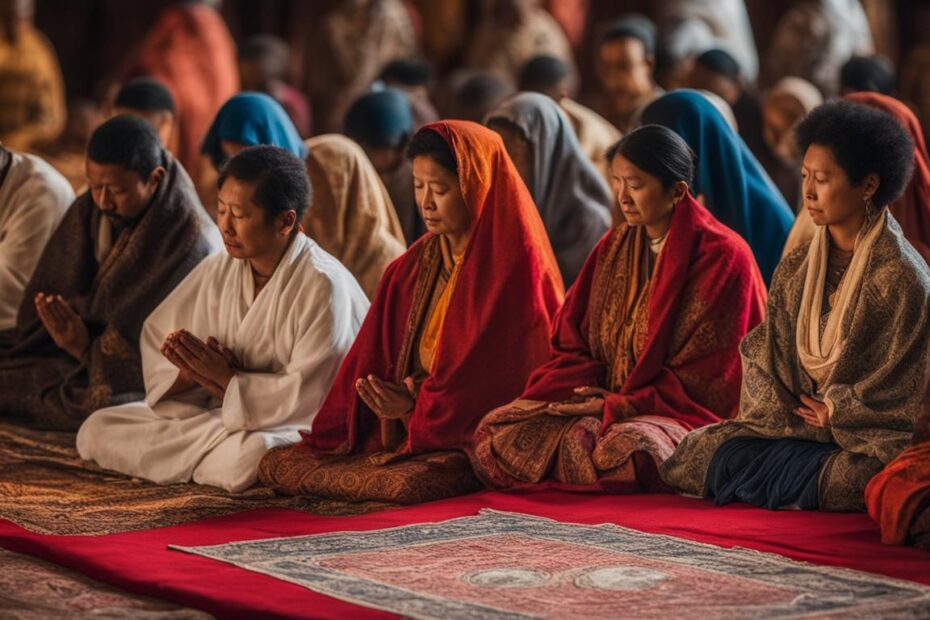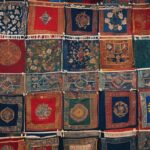Prayer cloths have a long and significant history in Christian tradition, serving as tangible representations of faith and vessels for invoking God’s healing power. While the term “prayer cloth” may not be found in the Bible, there are references to the use of physical objects for healing and the laying on of hands.
In this article, we will delve into the origins of prayer cloths, their symbolism in Christianity, and their use among believers. We will also address some of the controversies surrounding prayer cloths and offer insights into their purposes and practices.
Key Takeaways:
- Prayer cloths are recognized as sacramentals in certain church traditions.
- Although not mentioned by name in the Bible, prayer cloths have biblical basis in references to physical objects used for healing.
- Prayer cloths symbolize faith, hope, and surrender to God’s will.
- The use of prayer cloths varies among Christians and denominations.
- Critics question the effectiveness and biblical basis of prayer cloths.
Are Prayer Cloths Biblical?
While the specific term “prayer cloth” is not mentioned in the Bible, there are references to the use of physical objects for healing and the laying on of hands by Jesus and the apostle Paul. These references, such as the accounts of people touching the fringe of Jesus’ garment and the use of handkerchiefs and aprons touched by Paul, provide a biblical basis for the use of prayer cloths in Christian practice. However, it is important to note that the Bible does not prescribe the use of prayer cloths as a universal practice, but rather highlights specific instances of their use.
Jesus’ garment, particularly the fringe, held great significance in Jewish culture and was believed to possess healing power. In the New Testament, the Gospels of Matthew, Mark, and Luke all mention instances where people sought healing by touching the fringe of Jesus’ garment. In Matthew 9:20-22, a woman with a hemorrhage touches the fringe of Jesus’ garment and is healed. Similarly, in Mark 6:56, it is said that people from all around brought their sick to Jesus and “begged him that they might touch even the fringe of his cloak. And all who touched it were made well.” These accounts demonstrate the belief in the healing power associated with physical contact with objects of significance.
The use of prayer cloths by the apostle Paul is described in the book of Acts. In Acts 19:11-12, it is mentioned that “God did extraordinary miracles through Paul, so that even handkerchiefs or aprons that had touched his skin were carried away to the sick, and their diseases left them and the evil spirits came out of them.” This passage suggests that the power of healing was not necessarily in the cloth itself but in the faith and anointing associated with it. It is important to highlight that the use of prayer cloths is not a requirement for Christians, but rather a practice that some choose to engage in based on their interpretation of these biblical accounts.
In conclusion, while the term “prayer cloth” may not be explicitly mentioned in the Bible, there are biblical references that provide a basis for their use in Christian practice. These references highlight the belief in the healing power associated with physical objects and the efficacy of faith. It is important to approach the use of prayer cloths with an understanding of their symbolic significance and the individual’s personal faith and conviction.
The Symbolism of Prayer Cloths in Christianity
Prayer cloths hold significant religious symbolism in Christianity. They serve as physical representations of faith and act as a means to connect with God’s healing and protective presence. When a believer lays a prayer cloth on someone or uses it in personal prayer, it is an act of invoking divine intervention and expressing trust in God’s ability to bring about healing and blessings.
Prayer cloths also have a deeper meaning beyond their physical presence. They symbolize hope and the power of prayer. By using a prayer cloth, believers are reminded of their unwavering faith and dedication to surrender their cares to God. The cloth serves as a tangible reminder of God’s authority over their lives and their reliance on His love and grace.
It is important to note that the power of healing does not come from the cloth itself but from God. Prayer cloths are not objects of worship but rather tools to enhance one’s connection with the divine. They are a visual representation of the believer’s trust and reliance on God’s mercy and compassion.
The Significance of Prayer Cloths
Prayer cloths hold a deep significance and are used in various spiritual practices within Christianity. They are employed during prayers for the sick, seeking intercession, and invoking God’s healing presence. The act of using a prayer cloth signifies the believer’s active participation in their faith, demonstrating their willingness to seek God’s intervention and trust in His plans.
Moreover, prayer cloths also represent the unity and support of the Christian community. When believers give or receive a prayer cloth, it symbolizes the solidarity of fellow believers in supporting and uplifting one another. The cloth becomes a physical reminder that others are praying for the individual and a source of comfort during challenging times.

In conclusion, prayer cloths carry deep symbolism in Christianity. They represent faith, hope, and trust in God’s healing power. Despite any controversies or criticisms, prayer cloths remain a meaningful aspect of spiritual practices for those who choose to use them. The focus should always be on the genuine connection with God and the reliance on His divine guidance and intervention.
The Origins and Use of Prayer Handkerchiefs or Cloths
Prayer cloths have a rich history that can be traced back to the early Christian tradition. While the term “prayer cloth” is not specifically mentioned in the Bible, there are references to the use of physical objects for healing and the laying on of hands by Jesus and the apostle Paul. In the book of Acts, it is mentioned that the apostle Paul used handkerchiefs and aprons for healing purposes. This practice of using prayer cloths may have originated with the Mormons in the 1830s and later gained popularity in the Pentecostal church.
In their modern form, prayer cloths are often small pieces of fabric that are anointed with oil or the sweat of those who pray over them. They are used in various spiritual practices, including healing rituals and intercessory prayer. The belief is that these cloths serve as a physical representation of faith and a means of invoking God’s healing power. The act of using a prayer cloth in prayer is seen as a way to connect with God’s presence and seek divine intervention.
Over time, the use of prayer cloths has evolved, but their purpose remains the same – to serve as a tangible representation of faith and a tool for invoking God’s healing and protective power. While not all Christians use prayer cloths, they continue to be used by those who believe in their significance and find comfort in their use during times of sickness or need.
| Origins | Use | Evolution |
|---|---|---|
| The origins of prayer cloths can be traced back to the early Christian tradition. The practice may have originated with the Mormons in the 1830s. | Prayer cloths are used in various spiritual practices, including healing rituals and intercessory prayer. They are seen as a physical representation of faith and a means of invoking God’s healing power. | While prayer cloths have evolved over time, their purpose remains the same – to serve as a tangible representation of faith and a tool for invoking God’s healing and protective power. |
Do Christians Use Prayer Cloths?
While prayer cloths are not universally practiced among Christians, some individuals and churches choose to use them as a way to pray for and support the sick. The decision to use prayer cloths varies among denominations and individuals, with some seeing them as a meaningful symbol of faith and others focusing more on the power of prayer itself. It is important to note that the Bible does not command or prohibit the use of prayer cloths, leaving it up to individual interpretation and belief.
Prayer cloths, also known as prayer handkerchiefs, have a long history in Christian tradition and are seen as tangible representations of faith. They are often anointed with oil or the sweat of those who pray over them, and believers believe that carrying or placing these cloths on themselves or others can invoke divine intervention and healing. However, it is essential to emphasize that the power of healing comes from God, not the cloth itself. The focus should always be on faith in God’s sovereignty and trust in His ability to bring about healing and blessings.
While prayer cloths may not be universally practiced, they can provide comfort and encouragement to those who use them. They serve as physical reminders that others are praying for and supporting the person in need, symbolizing hope and the power of prayer. Ultimately, the use of prayer cloths is a personal choice and should be approached with respect for different interpretations and practices within Christianity.
Christian Beliefs about Prayer Cloths
Christian beliefs about prayer cloths vary, but they are often seen as a way to demonstrate faith and seek divine intervention. Some believers view prayer cloths as a means to physically connect with God’s healing power, while others see them as a symbol of trust in God’s ability to answer prayers. The use of prayer cloths is rooted in the belief that God can work through physical objects and that faith plays a crucial role in the healing process.
It’s important to note that the effectiveness and use of prayer cloths may differ among Christian denominations and individuals. Some denominations may place more emphasis on the use of prayer cloths as part of their spiritual practices, while others may view them as optional or not part of their tradition. Ultimately, the use of prayer cloths is a personal decision guided by individual beliefs and the teachings of each Christian community.
| Pros | Cons |
|---|---|
|
|
While the use of prayer cloths may not be embraced by all Christians, they continue to hold significance for those who believe in their healing power and symbolic value. Whether one chooses to use prayer cloths or not, it is essential to approach the topic with an open mind and respect different interpretations and practices within Christianity.
What Do You Do with a Prayer Cloth?
Prayer cloths hold a special place in the hearts of many Christians, serving as a tangible representation of faith and a source of comfort and encouragement. But what exactly do you do with a prayer cloth? How can you incorporate it into your prayer life and spiritual practice? Let’s explore the purpose of prayer cloths and how to use them effectively.
The Purpose of Prayer Cloths
The primary purpose of a prayer cloth is to serve as a physical reminder and symbol of faith. It represents the collective prayers and support of others, signifying their intercession on behalf of the person for whom the cloth is intended. When you receive a prayer cloth, it is essential to remember that the true power lies not in the cloth itself, but in the faith and trust in God’s healing and provision.
Prayer cloths are often used in praying for the sick or those in need of spiritual healing. They can also be used in personal prayer, providing a physical object to focus on and connect with during moments of quiet reflection and worship. Ultimately, the purpose of a prayer cloth is to bring comfort, hope, and a sense of God’s presence to those who receive it.
Using Prayer Cloths in Prayer
When using a prayer cloth in prayer, there are no strict rules or guidelines. However, here are some ways you can incorporate a prayer cloth into your prayer practice:
- Hold it in your hands: Grasp the prayer cloth in your hands as you pray, allowing it to serve as a physical reminder of the prayers being offered.
- Lay it on the person: If you are praying for someone specific, you can lay the prayer cloth on their body or place it under their pillow as a way of symbolically covering them in prayer.
- Keep it close: Some individuals choose to carry the prayer cloth with them or keep it in a special place where they spend most of their time, such as their bedside table or wallet. This helps maintain a constant connection with the prayers and support it represents.
Remember, the act of using a prayer cloth is not a guarantee of healing or answered prayers. Instead, it is a way to express your faith, release your cares to God, and trust in His ultimate plan and timing. Regardless of how you choose to use a prayer cloth, let it serve as a reminder of the power of prayer and the love and support of your fellow believers.

Table: Different Ways to Use a Prayer Cloth
| Method | Description |
|---|---|
| Hold it in your hands | Grasp the prayer cloth in your hands as you pray, allowing it to serve as a physical reminder of the prayers being offered. |
| Lay it on the person | If you are praying for someone specific, you can lay the prayer cloth on their body or place it under their pillow as a way of symbolically covering them in prayer. |
| Keep it close | Carry the prayer cloth with you or keep it in a special place where you spend most of your time, such as your bedside table or wallet. |
Remember to approach the use of a prayer cloth with reverence and respect, understanding that its power is derived from the faith and trust you place in God, rather than the cloth itself. And most importantly, let the act of using a prayer cloth deepen your connection with God and bring you closer to His healing and loving presence.
Controversies Surrounding Prayer Cloths
Prayer cloths, although regarded as sacred by some, have not been without their fair share of controversies and criticisms within the Christian community. One of the main criticisms revolves around the perception that the use of prayer cloths can be seen as superstitious or rooted in “magical thinking”. Skeptics often question their effectiveness and question their biblical basis, arguing that true faith should not rely on physical objects.
Additionally, some individuals raise concerns about the potential for misuse or misunderstanding of the purpose of prayer cloths. They emphasize that genuine faith should prioritize a direct connection with God through prayer, rather than relying on external objects. While prayer cloths may hold symbolism and serve as reminders of faith, there is a need for discernment to ensure that the focus remains on trust in God’s power rather than an overemphasis on the cloth itself.
It is important to approach the topic of prayer cloths with an open mind and respect for different interpretations and practices within Christianity. While controversies and criticisms exist, there are also many believers who find comfort and spiritual significance in the use of prayer cloths as a tangible expression of faith. Ultimately, the decision to use prayer cloths or not is a personal one, guided by individual beliefs and convictions.

The Role of Discernment
When engaging with the concept of prayer cloths, it is vital to exercise discernment and focus on the underlying principles of faith, rather than becoming overly fixated on the physical object itself. Prayer cloths should serve as a tool to deepen one’s connection with God and to express trust in His healing power, rather than a substitute for genuine faith and prayer.
Conclusion
Prayer cloths have a long and rich history in Christian tradition, serving as tangible expressions of faith and symbolic reminders of God’s healing power. While the term “prayer cloth” may not be found in the Bible, there are biblical references to the use of physical objects for healing and the laying on of hands. These references provide a basis for the use of prayer cloths in Christian practice, although their use is not universally prescribed.
The symbolism of prayer cloths in Christianity is significant, representing hope, trust, and surrender to God’s will. They serve as a physical connection to God’s healing and protective presence, invoking divine intervention and expressing belief in the power of prayer. Whether one chooses to use prayer cloths or not, it is important to remember that the focus should always be on faith in God and His sovereignty.
While there may be controversies and criticisms surrounding prayer cloths within the Christian community, it is essential to approach the topic with an open mind and respect for different interpretations and practices. Prayer cloths continue to be used in various spiritual practices today, providing comfort, encouragement, and a visible reminder of the support and prayers of others. Ultimately, prayer cloths symbolize the believer’s unwavering faith in God and His ability to bring about healing and blessings.
FAQ
Are prayer cloths mentioned in the Bible?
While the term “prayer cloth” is not found in the Bible, there are references to the use of physical objects for healing and the laying on of hands by Jesus and the apostle Paul.
What is the significance of prayer cloths in Christianity?
Prayer cloths are seen as tangible representations of faith and a means of invoking God’s healing power. They symbolize hope, trust, and surrender to God’s will.
What is the history of prayer cloths?
The use of prayer cloths can be traced back to early Christian tradition, with references to the apostle Paul using handkerchiefs and aprons for healing in the book of Acts.
Do all Christians use prayer cloths?
The use of prayer cloths varies among denominations and individuals. Some see them as a meaningful symbol of faith, while others focus more on the power of prayer itself.
How should I use a prayer cloth?
A prayer cloth is intended to be prayed over by others and then carried or kept in close proximity to the person for whom it was given. Some individuals choose to pin the prayer cloth to their clothing or keep it where they spend most of their time.
What are the controversies surrounding prayer cloths?
Prayer cloths have been subject to criticism and controversy within the Christian community. Some people view them as superstitious or a form of “magical thinking,” while others question their effectiveness and biblical basis.








